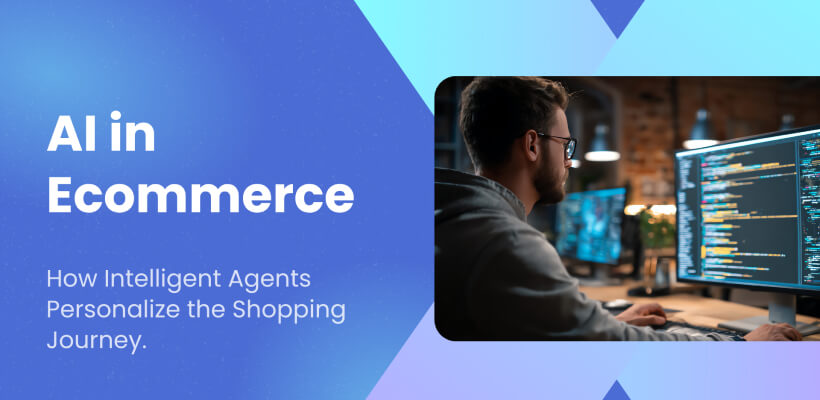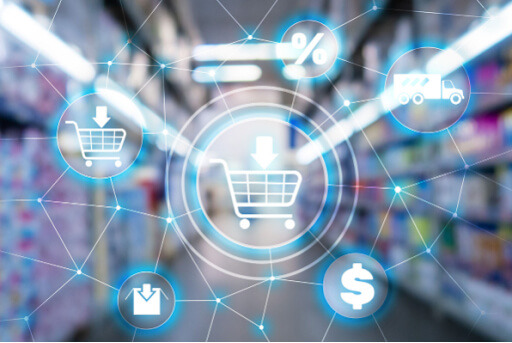 1-800-805-5783
1-800-805-5783 
Let’s set the baseline. AI in ecommerce is reshaping how people discover, compare, and buy products online.
Ecommerce keeps grabbing more of the total retail each year. Insider Intelligence projects $6.42T in worldwide retail ecommerce in 2025 and 20.5% of total retail sales, up from 19.9% in 2024.
At the same time, the AI in retail market is exploding. MarketsandMarkets pegs it at $31.1 billion in 2024, growing to $164.7 billion by 2030 (32% CAGR)—with personalization and virtual assistants among the fastest-adopted solutions.
And there’s plenty of headroom for impact: the global cart abandonment rate hovers around 70%, a persistent drag on growth. Even modest improvements in the journey pay off.
What this really means is that AI in ecommerce has scale, budgets, and a lot of low-hanging fruit. Intelligent agents are the lever.
Intelligent agents are AI systems that can perceive context, set sub-goals, use tools (search, inventory, pricing), and take actions—not just answer questions. Within AI in ecommerce, that looks like:
The shift is from static rules to agentic workflows that adapt in real time—a defining change in the new era.

Classic personalization relies on segments. AI in ecommerce now uses agents that understand intent, constraints, and context (budget, urgency, prior behavior) to construct shortlists and explain why each item fits.
Why it matters: even small lifts in relevance matter because overall ecommerce conversion rates are still in the low single digits—around 1.5–3% depending on category and season.
Business impact: Generative-AI-driven traffic to retail sites is already surging during peak seasons, signaling discovery is shifting toward conversational AI in ecommerce.
Agent playbook
Recommendations work best when they’re contextual—what fits this cart and this customer, right now. The revenue side is substantial: AI in ecommerce recommendation systems are pushing global AOV to around $140, driven by smarter bundling and upsells.
Agent playbook
Here’s the thing: ~70% of carts are abandoned—often due to unexpected costs, complex flows, or delivery uncertainty. Agents powered by AI in ecommerce can preempt these pain points: surface full cost earlier, check inventory by location, suggest alternate delivery windows, or initiate assisted checkout.
Agent playbook
Post-purchase is where loyalty is won. Agents in AI-powered ecommerce platforms can own routine tasks—order tracking, returns, warranty claims, replenishment—and trigger win-back prompts when sentiment dips.
Why it matters: ecommerce continues gaining retail share, so retention and repeat purchases will drive a bigger slice of growth.
Agent playbook

Behind the scenes, AI agents rely on:
To quantify AI in ecommerce impact, tie agent performance to hard metrics:
Given the high cart loss rates, even small improvements to transparency and checkout UX have outsized ROI.
Weeks 1–2: Map the journey and the data
Weeks 3–6: Launch two high-ROI agents
Weeks 7–10: Close the loop
Weeks 11–12: Optimize
Strong governance ensures AI in ecommerce remains transparent, secure, and customer-first.
These improvements validate why businesses adopting AI in ecommerce are outpacing those that haven’t modernized yet.
1) What’s the difference between chatbots and intelligent agents?
Chatbots answer questions. Agents pursue outcomes: they clarify needs, call tools (pricing, inventory, returns), and complete tasks—ideally with transparency and hand-off when confidence is low.
2) How big is AI’s footprint in retail/ecommerce right now?
Analysts expect fast growth. MarketsandMarkets estimates AI in retail will reach $164.7B by 2030 (32% CAGR), driven by personalization, virtual assistants, and computer vision.
3) Will agents actually move the needle on revenue?
Yes—because they attack friction in discovery and checkout. With high cart abandonment rates, even small improvements add up. As AOV trends upward globally (~$140), context-aware bundling and financing lift baskets higher through AI in ecommerce systems.
4) What KPIs should we monitor first?
Start with CVR, AOV, cart-to-checkout, checkout completion, and deflection-to-resolution. Then track NPS/CSAT to gauge satisfaction with AI in ecommerce interactions.
5) Is conversational discovery really growing, or just hype?
It’s growing—especially around peaks. Adobe’s seasonal forecasts show AI-influenced retail traffic spiking as shoppers use assistants for research and deal-finding.
6) What about security and misuse?
Treat agents like least-privilege employees: restrict tools, validate inputs/outputs, and log everything. Strong security design ensures AI in ecommerce systems stay compliant and trustworthy.
Personalization used to mean segments and rules. AI in ecommerce now means agents that understand context, reason about trade-offs, and act in real time. Start where the money leaks—discovery relevance and checkout clarity—and let measurable results guide the rest.
At [x]cube LABS, we craft intelligent AI agents, including chatbots in healthcare, that seamlessly integrate with your systems, enhancing efficiency and innovation:
Integrate our Agentic AI solutions to automate tasks, derive actionable insights, and deliver superior customer experiences effortlessly within your existing workflows.
For more information and to schedule a FREE demo, check out all our ready-to-deploy agents here.